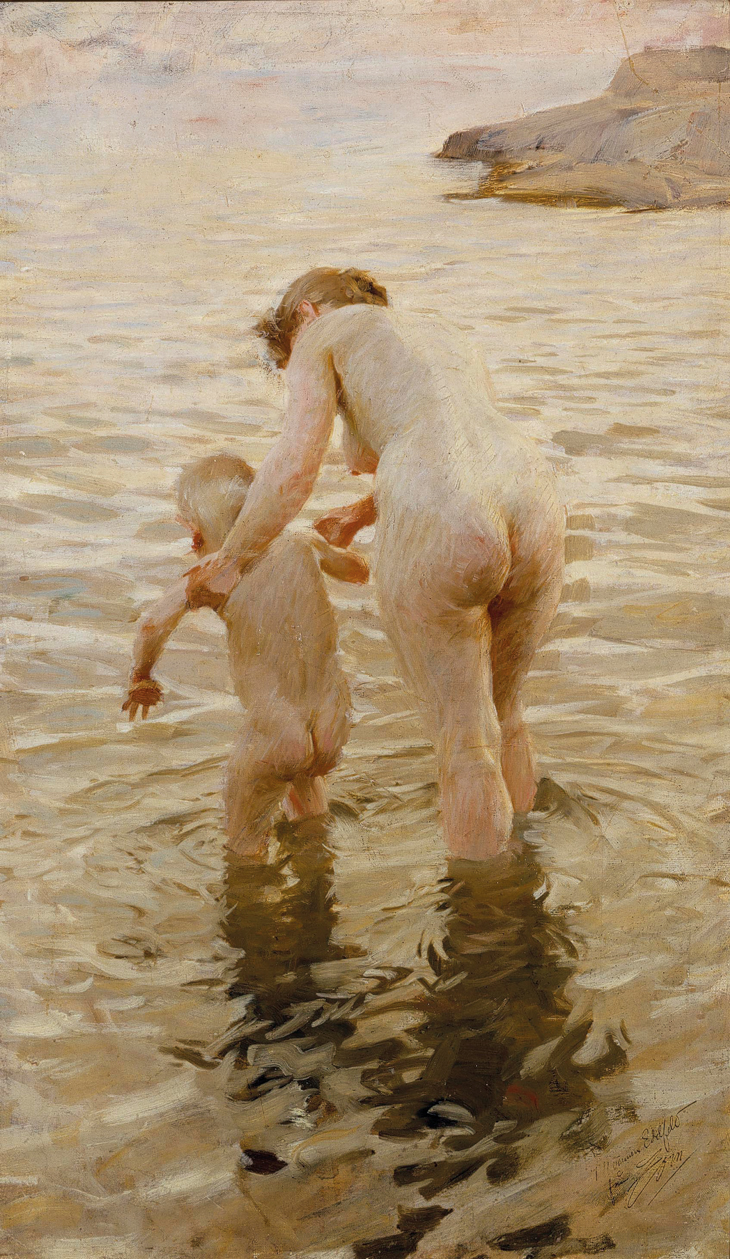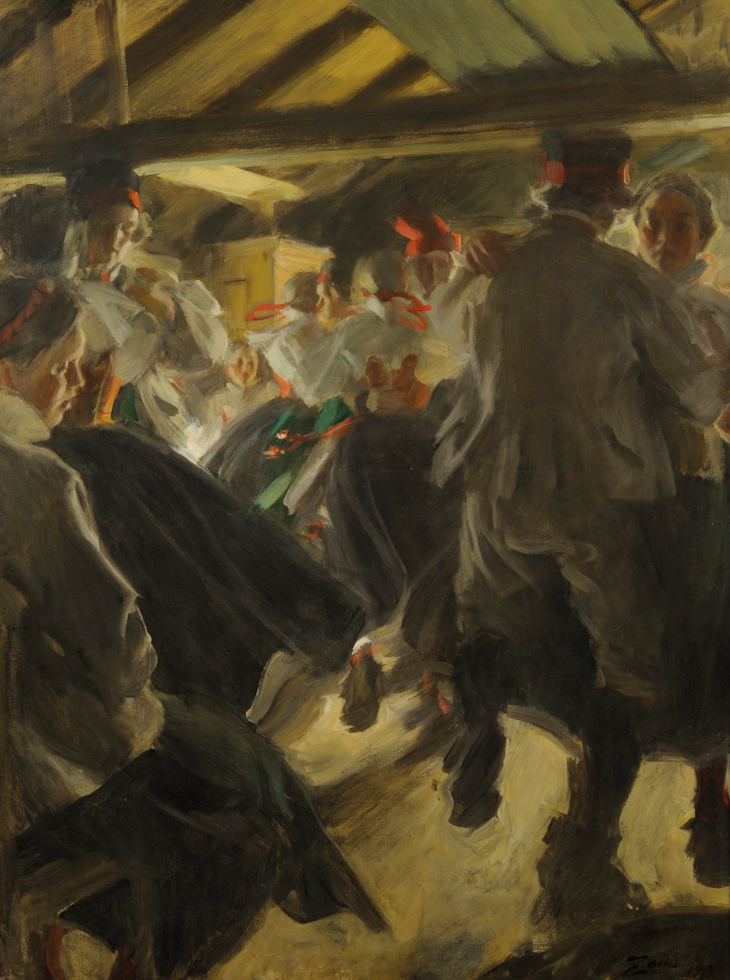In 1880, Anders Zorn showed a watercolour titled In Mourning at the Royal Academy of Fine Arts in Stockholm, where he’d been studying for five years after leaving his grandparents’ farm in Dalarna as a teenager. In Mourning is a delicate head of a girl in black crêpe and a fashionable black hat, her downcast glance and slight nose visible through a veil so fine and transparent it seems barely there. Zorn had a sharp eye for things that were almost invisible. His portraits of the Swedish journalist Johan Christian Janzon (1891) and General Meda at his bureau (1915) depict thin blue wreaths of smoke curling from the lit coals of cigarette and cigar, flourishes of the brush that dance over the surface of each picture. Ethereal effects like this were part of a confident, risky technique that became his hallmark, a way of laying his process bare by applying relatively few, clearly discernible brushstrokes that could not be undone without starting again. The ‘Anders Zorn’ exhibition at the Kunstmuseum Den Haag shows us the chronological development of this confidence across a glittering international career: from the fat horizontal strips of paint in Old Ann (1887), an early oil depiction of a peasant woman bent over her work, to the dash and verve of his high-society portraits.
In his depictions of peasant life Zorn moved between conventional genre painting – the anecdotal Market in Mora (1892), for instance, where an exasperated woman whose husband has collapsed drunk waits for him to regain consciousness while the rest of the village surges by on market day – to more naturalistic, avant-garde work. In Gypsy Forge (1885), painted in Romania, the peasant family in the open doorway are harshly lit and brought into sharp focus rather than romantically blurred. The First Time (1888), a medal-winner at the 1889 Paris Universal Exposition, mixes narrative (a mother leading her anxious little son into the sea at Dalarö) with a shimmering, enveloping treatment of light on waves that brings the composition into contact with the pictorial world of Impressionism. But not too close: Zorn’s interest, as he explained in his autobiographical notes, wasn’t in snapshot-style immediacy but in the possibility of ‘solving’ the problem of representing reflection on water as a mathematician solves a puzzle, explaining a phenomenon rather than capturing its changing faces.

The First Time (1888), Anders Zorn. Finnish National Gallery, Ateneum Art Museum, Helsinki. Photo: Finnish National Gallery, Jouko Könönen
In 1888 he moved to Paris, as his portrait of the French banker and art collector Ernest May’s children brought him a slew of commissions and introductions in the capital. As the exhibition argues, Zorn was fascinated by urban modernity and high society as much as by the slower pace of rural life. He painted the former arts minister Antonin Proust, Proust’s dancer mistress Rosita Mauri and the famous actor Coquelin Cadet (hands clasped eloquently as if mid speech); by the end of the 1890s, he had graduated to painting the king of Sweden and a recent president of the United States. He used colour dramatically as a means of getting at character. Night Effect (1894) shows a preening woman outside a Paris restaurant, the flamboyant red of her dress picking out the plumes on her hat in the same shade and the swipe of lipstick on her open mouth. In 1915, he placed himself inside the milieu he admired with his Self-Portrait in Red. The swagger of the artist’s tomato-red three-piece suit and silk tie – coupled, again, with the barely visible upwards curl of his cigarette smoke – are clear indicators of how far he has come. (Zorn liked red: when the Finnish art collector Herman Antell arrived drunk with flushed cheeks to his studio to have his portrait painted, the painter was delighted and served him punch at all subsequent meetings. ‘You are such a good colour.’)

Self-Portrait in Red (1915), Anders Zorn. Zornmuseet, Mora
The Kunstmuseum devotes a room to Zorn’s evolving preoccupation with women and his way of blurring class boundaries in depicting female bodies. Clara Rikoff, the wife of a well-to-do banker, admired the boudoir portrait he’d painted of Proust’s mistress and had him transpose her to a similar setting, languishing in satin robes in a hazily-lit bedroom with a lapdog at her feet. Étude Éclairage (1899) was shown at the Salon without Rikoff’s name attached. For his female nudes, Zorn chose models from the working classes who needed the extra income – cleaners, waitresses, factory workers, prostitutes, thieves. Some he photographed privately without turning the images into compositions: Nude Study in Studio: Woman Smoking, for instance, shows a model slumped casually in a chair puffing on a cigarette, corset and stockings discarded behind her. (Zorn’s use of photography both as an aid to painting and an art form in its own right is one of the most interesting aspects of the exhibition.)
Something of this naturalistic, unposed-posed quality survives in his oil compositions. There is a shocking unreadiness to his Venus de la Villette (1891), in which the childlike model looks out frankly as if startled, a towel hanging from one arm; while in Soir (1892) and Girls from Dalarna Having a Bath (1906), the subjects’ complete unawareness of being watched as they prepare for bed places the viewer somewhere between voyeur and ignored. If these compositions exemplify what the curators call Zorn’s ‘typical’ male gaze, other pieces are odder and more self-conscious. Self-Portrait (1896) and the photograph Nude Study in the Archipelago insert the artist in the frame along with the women he depicts, putting the looker in the ambiguous position of the looked-at.

Herdsmaid (1908), Anders Zorn. Zornmuseet, Mora
In 1896 Zorn moved permanently back to Dalarna and his native village of Mora, one of several contemporary Swedish artists and writers attracted by romantic nationalist visions of folk culture. He became a kind of celebrity antiquarian, collecting traditional objects and resuscitating customs and practices that had died out. The world he exported in large-scale oil paintings during this period is timeless and ritualistic: a young herdsmaid seen through the pine trees doing the job her mother and grandmother would have done; Mora church on Christmas morning splashed with red and green, bathed in candlelight. The rapid movement he conveys in Midsummer Dance (1897) and Dance in Gopsmor Cottage (1914) – skirts flying, feet in mid-air – is the sort of movement a spinning top needs if it isn’t to come to halt and collapse: the defiant continuation of a way of life under pressure from all directions.

Dance in Gopsmor Cottage (1914), Anders Zorn. Zornmuseet, Mora
The Kunstmuseum den Haag is temporarily closed to the public due to Covid-19 restrictions. For more information on ‘Anders Zorn’ (scheduled to run until 31 January) visit the institution’s website.
From the January 2021 issue of Apollo. Preview and subscribe here.














![Masterpiece [Re]discovery 2022. Photo: Ben Fisher Photography, courtesy of Masterpiece London](http://zephr.apollo-magazine.com/wp-content/uploads/2022/07/MPL2022_4263.jpg)
‘Like landscape, his objects seem to breathe’: Gordon Baldwin (1932–2025)